AI City Planners: Algorithms Optimizing Traffic & Housing Density
The world is constantly evolving and so are our cities. With population growth and urbanization on the rise, cities are facing increasing challenges in managing traffic congestion and housing density. However, with the rapid development of technology, a solution is on the horizon – AI City Planners.
The Role of AI City Planners
AI City Planners are software programs designed to optimize and manage city infrastructure, specifically in terms of traffic and housing density. These algorithms use advanced data analysis and prediction models to make intelligent decisions and recommendations for urban planning.
Traffic Optimization
One of the major problems faced by cities is traffic congestion. With more and more vehicles on the road, the roads are becoming increasingly congested leading to longer commute times and increased air pollution. However, AI City Planners are equipped with machine learning algorithms that can analyze traffic patterns and make real-time adjustments to optimize the flow of traffic.
For instance, traffic signals can be controlled by AI City Planners to adapt to changing traffic conditions and reduce wait times at intersections. They can also monitor and manage public transportation systems, improving the efficiency and reliability of buses and trains.
Another fascinating aspect of AI City Planners is their integration with smart cars. These algorithms can communicate with smart cars to provide real-time traffic updates, reducing the chances of accidents and improving the overall flow of traffic.
Housing Density Optimization
The other key aspect of urban planning is managing housing density. With a growing population, cities are facing a shortage of affordable housing. AI City Planners can address this issue by analyzing data on population growth, demographic trends, and housing availability to make informed decisions on where and how much affordable housing should be built.
Moreover, these algorithms can also optimize the use of existing space in the city to maximize housing density. By analyzing data on vacant buildings and underutilized spaces, AI City Planners can recommend strategies such as converting commercial buildings into residential spaces or constructing multi-story buildings on smaller plots of land.
The Benefits of AI City Planners
The implementation of AI City Planners has numerous benefits for cities and its inhabitants. Firstly, it can significantly reduce traffic congestion, resulting in shorter commute times and reduced emissions from idling vehicles. This, in turn, can improve air quality and reduce the carbon footprint of the city.
Secondly, with AI City Planners optimizing housing density, affordable housing can be made more accessible to the growing population. This will not only improve the quality of life for residents but also attract more people to live and work in the city, boosting the local economy.
Moreover, AI City Planners eliminate human error and bias from urban planning, leading to more efficient and equitable decision-making. This technology can also adapt to changing conditions and continuously improve, making city planning a more agile and dynamic process.
The Future of Cities
AI City Planners are still in their early stages of development and implementation, but they have the potential to revolutionize the way cities are designed and managed. With the rapid advancements in technology, we can expect to see more cities adopting AI City Planners in the near future.
However, it is important to note that these algorithms are not meant to replace human city planners but rather enhance their capabilities. The decision-making and final approvals will still lie in the hands of city officials, but with the support of AI, they can make more informed and efficient decisions.
Conclusion
The rise of AI City Planners marks a significant step towards creating smarter, more efficient, and sustainable cities. These algorithms have the potential to save time, reduce costs, and improve the quality of life for city-dwellers. As technology continues to advance, we can expect to see more innovative solutions for the challenges faced by our cities.











